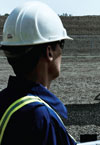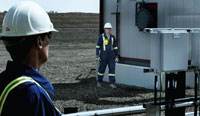
Seeing is Believing
Flashing lights and other visual cues on new confined space gas monitors confirm at a glance whether the crew is safe and the site is compliant.
- By Patrick Hogan
- Feb 01, 2010

When it was announced that fatality rates on U.S. roadways had sharply declined in the past 40 years, traffic control experts had a quick explanation: They pointed to the increased use of visual cues, such as reflective signs, raised pavement markers, and rumble strips.
For decades, in industries such as aviation and highway construction, federal law has dictated that flashing warning lights be used to improve collision avoidance. In recent years, advancements in LED lighting have produced a new generation of low-power LED strobe lights that have improved nighttime safety illumination for bicycles and motorized craft. Because the brain processes visual cues more rapidly than other forms of communication, the use of flashing confidence lights and other visual cues has vast implications for also improving safety in life safety instrumentation, such as portable gas monitors.
Making Compliance Easy
Manufacturers of confined space portable gas monitors have introduced an intelligent new technology of flash illumination for use in confined space portable gas monitors. One example is a four-gas portable gas monitor in which the technology manifests itself as a bright, flashing green LED light on the portable unit, serving as a visual confidence check or safety audit. It allows a safety supervisor to visually confirm at a glance, up to 20 feet away from the operator in broad daylight, the portable gas detector has been properly calibrated or bump tested with gas.
Today, it is a mandatory OSHA requirement that each worker equipped with a confined space portable gas detector ensure the unit is tested and working prior to passing through the security gate into the hazardous area. In other words, the portable gas monitor should have passed a functional "bump test" or even a calibration check, in addition to the entire safety audit of personal protective equipment that includes hats, boots, harness, gloves, and other safety gear.
Up to now, the task of confirming visually whether a gas monitor was fit for confined space operation was not a process carried out in split seconds. In fact, the task could be laborious, delayed, or even introduce errors into the process. The safety manager or security guard had to inspect the gas monitors visually, but doing so meant navigating a complex soft ware menu on the interface, a modest computer skill but one that many workers (particularly temporary workers new to the job) simply did not have. At the very least, a delayed worker means that productive time is lost for the company; at worst, a noncompliant worker is admitted into a confined space without the protection of a fully functioning and sensing personal gas monitor.
The visual compliance provided by the LED blinking light makes the safety audit faster and more eff ective by removing the need for experienced auditors to check each device. Moreover, it comes with a proven date and time stamp that aids the safety officer with recordkeeping. It also flags instruments that fail to meet the gas testing criteria so these instruments can be removed from the field at once and sent for repair or replacement. For emergency work carried out around the clock, where time is a critical element in getting the process back to safe working status, this rapid identification and removal of unfit instruments ensures maximum uptime and worker productivity.
The intelligent flashing feature, along with datalogging, is also a great time saver for the busy safety manager, significantly reducing the amount of paperwork and unnecessary double checking. More importantly, it is now much less likely for an operator to enter a confined space without a pre-tested gas monitor, which would be dangerous for both the operator and his colleagues, as well as making the company liable for potential OSHA investigations or fines, should an incident occur.
Other Safety Advancements
In addition to the intelligent flashing feature, manufacturers of personal gas monitors have developed other visual features, such as simple one-button operation along with a large backlit LCD screen, that make the gas monitor easy to interact with and reduce training time.
Innovations in battery technology are creating additional cost savings in step with greater personal safety. The extended battery life of some portable gas monitors increases runtimes even in lower-temperature conditions where normally batteries don't hold their full charge. Interchangeable battery packs allow the unit to be recharged quickly to continue to provide safety cover when plants are operating 24/7. This avoids the need to return the units back to the instrument shack for conventional safe area recharging and also means fewer portables need to be purchased to cover the needs of the plant staff.
Downtime is the most costly expense to any operation. For typical industries, it can equal $5,000 to $10,000 per hour of lost productivity and worker costs.
Split Seconds Make the Difference
To summarize, we are seeing gas detectors use innovations in intuitive display, battery management, and operational ease, providing a future road map of more integrated and intelligent monitoring solutions. The goal is to exploit more additional functionality out of the essential gas detector platform to drive greater productivity and prevent downtime at all points in a typical worker's shift.
Through at-a-glance visual cues, such as the flashing confidence light, safety compliance is made easier. One doesn't even have to think about whether the portable gas monitor has been bump tested or whether the sensors are working properly. The safety manager can now rapidly check that all staff and contract laborers are compliant and ready to start work. Furthermore, his or her assurance is backed with the knowledge that the portable devices and docking modules in the instrument shack have a complete record of each gas monitor and its essential bump test history. If the flashing light stops flashing at any point during the day, the operator and supervisor will know immediately there is a problem with one of the sensors and can have the unit checked out. This saves time and cost and ensures maximum productivity from the workforce.
The visual confidence flash makes it easier and more economical for the safety officer to comply with the spirit as well as the letter of all national and corporate safety laws. The overall impact to the business is a smarter, safer, and more cost-effective working environment.
This article originally appeared in the February 2010 issue of Occupational Health & Safety.